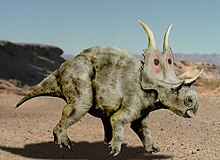Wahweap Formation
| Wahweap Formation | |
|---|---|
| Stratigraphic range: Campanian | |
| Type | Geological formation |
| Location | |
| Coordinates | 37°30′N 111°42′W / 37.5°N 111.7°W |
| Region | North America |
| Country | |
| Extent | Southern Utah, Northern Arizona |
| Type section | |
| Named for | Wahweap Creek |
The Wahweap Formation of the Grand Staircase-Escalante National Monument is a geological formation in southern Utah and northern Arizona, around the Lake Powell region, whose strata date back to the Late Cretaceous (Campanian stage). Dinosaur remains are among the fossils that have been recovered from the formation.[1]
Paleobiota
Invertebrates
The Wahweap Formation shows a substantial amount of invertebrate activity ranging from fossilized insect burrows in petrified logs[2] to various mollusks that characterize the shell beds. Large fossilized crabs are common at most shell bed sites in the Wahweap,[3] and over 1,900 gastropod specimens (of four likely genera) have been unearthed in the formation's siltstone.[4]
Fishes
In addition to terrestrial vertebrates, freshwater fish fossils have been uncovered from the Wahweap which include bowfin vertebrae,[4] ray teeth,[5] and probable lungfish burrows.[6]
Dinosaurs
Dinosaurs known from the Wahweap include, at least 2 species of hadrosaur, at least two ceratopsians[7] and at least one theropod.[8]
Color key
|
Notes Uncertain or tentative taxa are in small text; |
| Dinosaurs of the Wahweap Formation
| ||||||
|---|---|---|---|---|---|---|
| Genus | Species | State | Member | Abundance | Notes | Images |
|
A. hutchisoni |
One partial maxilla. |
 | ||||
|
A. gagslarsoni |
A hadrosaurid closely related to Brachylophosaurus and Maiasaura |
 | ||||
|
L. argestes |
 | |||||
|
D. eatoni |
Lower middle |
Two incomplete skulls |
The oldest known centrosaurine dinosaur |  | ||
|
M. cronusi |
Upper |
A partial skull |
A centrosaurine closely related to Diabloceratops |  | ||
Mammals

A fair number of mammals spanning the lower Campanian are known from the Wahweap as well, including at least 15 genera of multituberculates, cladotherians, marsupials, and placental insectivores.[12]
Trace fossils
Trace fossils are also relatively abundant in the Wahweap, and include vertebrate tracks as well as burrow activity. Tracks preserved in the capping sandstone indicate the presence of crocodylomorphs, which had been previously known in this area only from teeth elements, as well as ornithischian dinosaurs. At least one possible theropod track has been identified in this area as well.[13]
In 2010 a unique trace fossil from the Wahweap was discovered that indicates a predator–prey relationship between dinosaurs and primitive mammals. The trace fossil includes at least two fossilized mammalian den complexes as well as associated digging grooves presumably caused by a maniraptoran dinosaur. The proximity indicates a case of probable active predation of the burrow inhabitants by the owners of the claw marks.[11]
See also
References
- ^ Weishampel, David B; et al. (2004). "Dinosaur distribution (Late Cretaceous, North America)." In: Weishampel, David B.; Dodson, Peter; and Osmólska, Halszka (eds.): The Dinosauria, 2nd, Berkeley: University of California Press. Pp. 574–588. ISBN 0-520-24209-2.
- ^ De Blieux, Donald D. "Analysis of Jim's hadrosaur site; a dinosaur site in the middle Campanian (Cretaceous) Wahweap Formation of Grand Staircase-Escalante National Monument (GSENM), southern Utah." Abstracts with Programs – Geological Society of America, vol. 39, no. 5, pp.6, May 2007
- ^ Kirkland, James Ian. "An inventory of paleontological resources in the lower Wahweap Formation (lower Campanian), southern Kaiparowits Plateau, Grand Staircase-Escalante National Monument, Utah." Abstracts with Programs – Geological Society of America, vol.37, no.7, pp.114, Oct 2005.
- ^ a b Williams, Jessica A J; Lohrengel, C Frederick. Preliminary study of freshwater gastropods in the Wahweap Formation, Bryce Canyon National Park, Utah. Abstracts with Programs – Geological Society of America, vol. 39, no. 5, pp.43, May 2007
- ^ Thompson, Cameron R. "A preliminary report on biostratigraphy of Cretaceous freshwater rays, Wahweap Formation and John Henry Member of the Straight Cliffs Formation, southern Utah." Abstracts with Programs – Geological Society of America, vol.36, no.4, pp.91, Apr 2004
- ^ Orsulak, Megan et al. "A lungfish burrow in late Cretaceous upper capping sandstone member of the Wahweap Formation Cockscomb area, Grand Staircase-Escalante National Monument, Utah." Abstracts with Programs – Geological Society of America, vol. 39, no. 5, pp.43, May 2007
- ^ http://geology.utah.gov/surveynotes/articles/pdf/horned_dinos_39-3.pdf
- ^ John Wesley Powell Memorial Museum display, visited April 30, 2009
- ^ Gates, Jinnah, Levitt, and Getty, 2014. New hadrosaurid (Dinosauria, Ornithopoda) specimens from the lower-middle Campanian Wahweap Formation of southern Utah. pp. 156–173. In The Hadrosaurs: Proceedings of the International Hadrosaur Symposium (D. A. Eberth and D. C. Evans, eds), Indiana University Press, Bloomington.
- ^ Gates, T.A.; Horner, J.R.; Hanna, R.R.; Nelson, C.R. (2011). "New unadorned hadrosaurine hadrosaurid (Dinosauria, Ornithopoda) from the Campanian of North America". Journal of Vertebrate Paleontology. 31 (4): 798–811. doi:10.1080/02724634.2011.577854.
- ^ a b Simpson, Edward L.; Hilbert-Wolf, Hannah L.; Wizevich, Michael C.; Tindall, Sarah E.; Fasinski, Ben R.; Storm, Lauren P.; Needle, Mattathias D. (2010). "Predatory digging behavior by dinosaurs". Geology. 38 (8): 699–702. doi:10.1130/G31019.1.
- ^ Eaton, Jeffrey G; Cifelli, Richard L. "Review of Cretaceous mammalian paleontology; Grand Staircase-Escalante National Monument, Utah. Abstracts with Programs – Geological Society of America, vol.37, no.7, pp.115, Oct 2005
- ^ Tester, Edward et al. Isolated vertebrate tracks from the Upper Cretaceous capping sandstone member of the Wahweap Formation; Grand Staircase-Escalante National Monument, Utah Abstracts with Programs – Geological Society of America, vol. 39, no. 5, pp.42, May 2007
